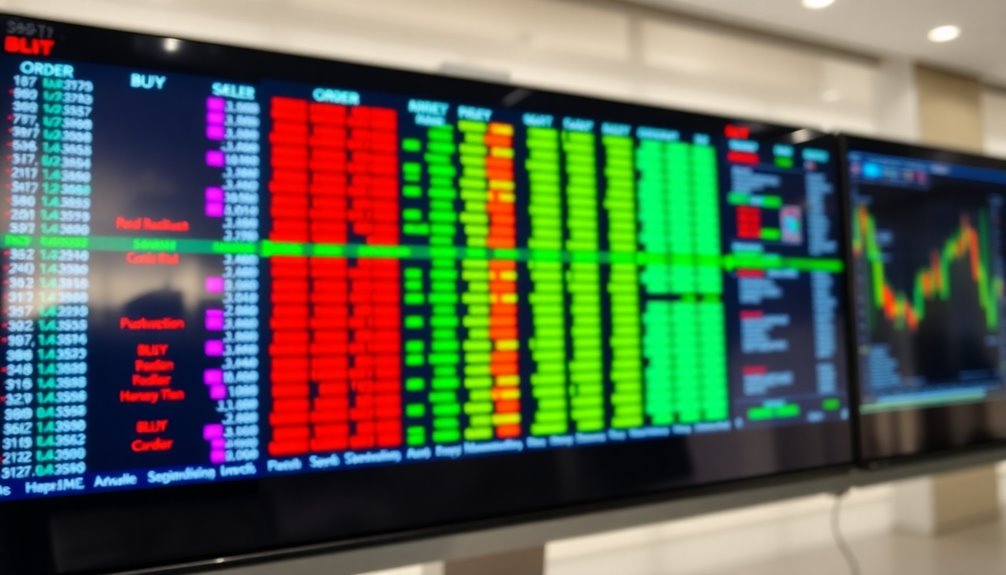An orderbook is a vital tool in trading that shows you live buy and sell orders for specific assets. It's divided into two main parts: the bid side, where buyers state prices they're willing to pay, and the ask side, where sellers list their prices. This digital list helps you understand market demand and supply, offering insights into price levels and liquidity. By tracking order depth and the bid-ask spread, you can make informed trading decisions. Want to explore how it impacts your trading strategies? There's more to uncover about its benefits and limitations.
Key Takeaways
- An orderbook is a digital platform displaying real-time buy and sell orders for a specific asset, indicating market demand and supply.
- It consists of two main sections: the bid side (buy orders) and the ask side (sell orders), reflecting market liquidity.
- The orderbook aids in price discovery, helping traders assess market sentiment and potential price movements through order flow analysis.
- Orders in the orderbook undergo a matching process based on price-time priority, ensuring fair execution of trades.
- While enhancing market transparency, the orderbook can be subject to manipulation and may not always reflect true market conditions during volatility.
Orderbook Overview

An order book is a crucial tool in trading, as it provides a real-time snapshot of the market's supply and demand dynamics.
You'll notice two main sections: the bid side, showing buy orders in descending price order, and the ask side, displaying sell orders in ascending price order.
Each line reflects a specific buy or sell proposition, with volume totals at each price point, indicating market liquidity. This structured format helps you understand market depth and pricing. The order book serves as a key tool for traders entering or exiting positions, providing valuable insights into market dynamics.
With instant updates, the order book keeps you informed about current market conditions, enhancing trade transparency.
Understanding Orderbook Basics

Understanding the order book is essential for navigating the trading landscape effectively. The order book consists of two main sections: the bid side, which lists buy orders, and the ask side, which lists sell orders. Buy orders appear in descending order, while sell orders are in ascending order. Each entry shows the order price, size, and placement time. The bid-ask spread formed by the highest bid and lowest ask price indicates market liquidity and is a crucial aspect for traders to consider.
You'll encounter limit orders that execute at specific prices and market orders that fill immediately at the best available price. The order book updates in real-time, reflecting market sentiment and liquidity.
Order Matching Process Explained

When traders submit their orders, they enter a complex matching process that ensures transactions occur efficiently. Orders, whether market or limit, are routed to an exchange where they're time-stamped for priority.
The order book organizes these orders by price level, separating buy and sell orders. The matching engine then compares incoming orders with those already in the book, applying a price-time priority system. This means the highest bid or lowest ask is matched first. Matching orders are vital for maintaining liquidity and facilitating price discovery in the market.
If an order can't be fully executed, the remaining quantity returns to the queue. Displayed orders take precedence over hidden ones at the same price level, ensuring a fair and orderly market for all participants involved.
Pros and Cons

While order books offer significant advantages, they also come with drawbacks that traders should be aware of. You'll find that their transparency allows for informed decisions, but the complexity can be overwhelming, especially for beginners. The control you gain over your trades is beneficial, yet it also demands a solid understanding of various order types. Price discovery helps reflect true market sentiment, but rapid volatility can lead to unexpected executions. Furthermore, while order books enhance market efficiency, they can be susceptible to order book manipulation by unscrupulous traders. Lastly, the information available may be limited or delayed, making it challenging to get a complete picture of market conditions. Balancing these pros and cons is crucial for successful trading.
Orderbook vs. Traditional Markets

Order books provide a distinct contrast to traditional markets by showcasing all active buy and sell orders, thus enhancing transparency and enabling traders to make more informed decisions.
In an order-driven market, you can see the bid and ask prices along with their volumes, giving you immediate insights into market sentiment and trends. This real-time data helps you identify significant entry and exit points, essential for executing effective trading strategies. Unlike quote-driven markets, where only market makers' bids and asks are visible, order books display all individual orders, fostering a more fluid and dynamic trading environment. This level of transparency offers you greater control and precision, particularly vital for high-volume and complex trading activities, as market makers ensure liquidity by continuously placing orders, enhancing market fluidity.
Market Volatility Concerns

Market volatility can significantly impact trading strategies, making it crucial for traders to understand how it interacts with the order book. In high volatility regimes, trading costs rise, and liquidity can drop sharply due to volatility shocks. However, during these periods, the order book may see an influx of limit orders, adding liquidity. You'll notice that the relationship between liquidity and volatility isn't straightforward; it can fluctuate based on market conditions.
Pay attention to the bid-ask spread, as a narrow spread indicates high liquidity, while a wide spread suggests the opposite. Additionally, order imbalances can reveal market sentiment, helping you gauge bullish or bearish trends. Understanding these dynamics will enhance your trading effectiveness in volatile markets. The order book slope of the buy side is often more informative regarding future volatility, which can further guide trading decisions.
Algorithmic Trading Innovations

Understanding market volatility is key, but it's just as important to keep up with the latest innovations in algorithmic trading.
AI and machine learning are transforming how you approach trading, enhancing your real-time decision-making and efficiency. By using predictive analytics, your algorithms can adapt strategies dynamically based on live market data. Customized AI tools provide domain-specific insights, optimizing your strategies further.
On the cutting edge, quantum computing offers unparalleled computational power, allowing you to explore multiple market scenarios at once. This integration of quantum algorithms with AI, known as QuantumAI, improves market analysis and performance. Moreover, big data analytics is increasingly being utilized to extract deeper market insights, further refining your trading strategies.
With these advancements, you can enhance risk assessment and anticipate potential losses, making your trading approach smarter and more effective.
Utilize Limit Orders Effectively

While you might be eager to jump into a trade, utilizing limit orders effectively can enhance your trading strategy significantly.
Limit orders let you buy or sell a security at a specified price or better, giving you control over the execution price. When you anticipate a price drop or rise, placing a limit order can help you avoid overpaying or selling too cheaply. Keep in mind that execution is not assured in volatile markets, so be patient; your order may not fill immediately.
Using limit orders alongside stop orders can further manage your risk. By integrating them with the order book, you can make informed decisions based on market transparency and order imbalances.
Frequently Asked Questions
How Does an Orderbook Affect Market Liquidity?
An order book significantly impacts market liquidity by organizing buy and sell orders at various price levels.
When you place a market order, it matches existing limit orders, facilitating immediate trades and enhancing liquidity.
Limit orders, on the other hand, add depth to the book, allowing for efficient price absorption.
Imbalances between buy and sell orders can indicate future price movements, guiding your trading strategies and market decisions effectively.
Can Orderbooks Be Manipulated by Traders?
Yes, order books can be manipulated by traders.
You might encounter tactics like spoofing, where large fake orders mislead you about market demand.
Layering can create false support or resistance levels, affecting your decisions.
Iceberg orders hide true buying interest, leaving you unaware of real market conditions.
Wash trading gives a false sense of activity, enticing you to participate in misleading trends.
Staying informed about these manipulations helps you navigate the market more effectively.
What Types of Assets Use Orderbooks?
When you think about order books, you'll find they're used across various asset types.
In financial markets, stocks, commodities, bonds, futures, and options all rely on them.
In the cryptocurrency realm, Bitcoin, altcoins, tokens, stablecoins, and DeFi tokens utilize order books for trading.
Additionally, both centralized and decentralized exchanges employ these systems, ensuring efficient order management and execution for a wide range of assets you might be interested in.
How Do Fees Impact Orderbook Trading?
Fees significantly impact your order book trading experience.
When you place market orders, you'll incur taker fees, while limit orders can lead to maker fees. These costs influence your decision-making, as higher fees might deter you from certain order types, reducing liquidity and widening bid-ask spreads.
Ultimately, you need to consider how these fees affect your trading costs and profitability, especially if you're a frequent trader navigating different platforms.
Are There Alternatives to Traditional Orderbooks?
Imagine a bustling marketplace where traders exchange goods without barriers.
You've got alternatives to traditional orderbooks, like Automated Market Makers (AMMs), which use algorithms to streamline trades.
Decentralized Exchanges (DEXs) let you keep control of your assets while ensuring security.
Layer 2 solutions enhance trading efficiency, while Concentrated Liquidity Protocols optimize capital use.
These innovative platforms transform trading into a seamless experience, empowering you to navigate the market dynamically and efficiently.
Conclusion
In the bustling marketplace of dreams, your orderbook is the compass guiding you through. Embrace its power to navigate the tides of trade, where each order is a whisper of your ambition. Yet, remember, like a ship in stormy seas, volatility can test your resolve. Harness the wisdom of algorithms and the finesse of limit orders to steer your course. With the right tools in hand, you'll not only survive the tempest but thrive in the adventure ahead.









